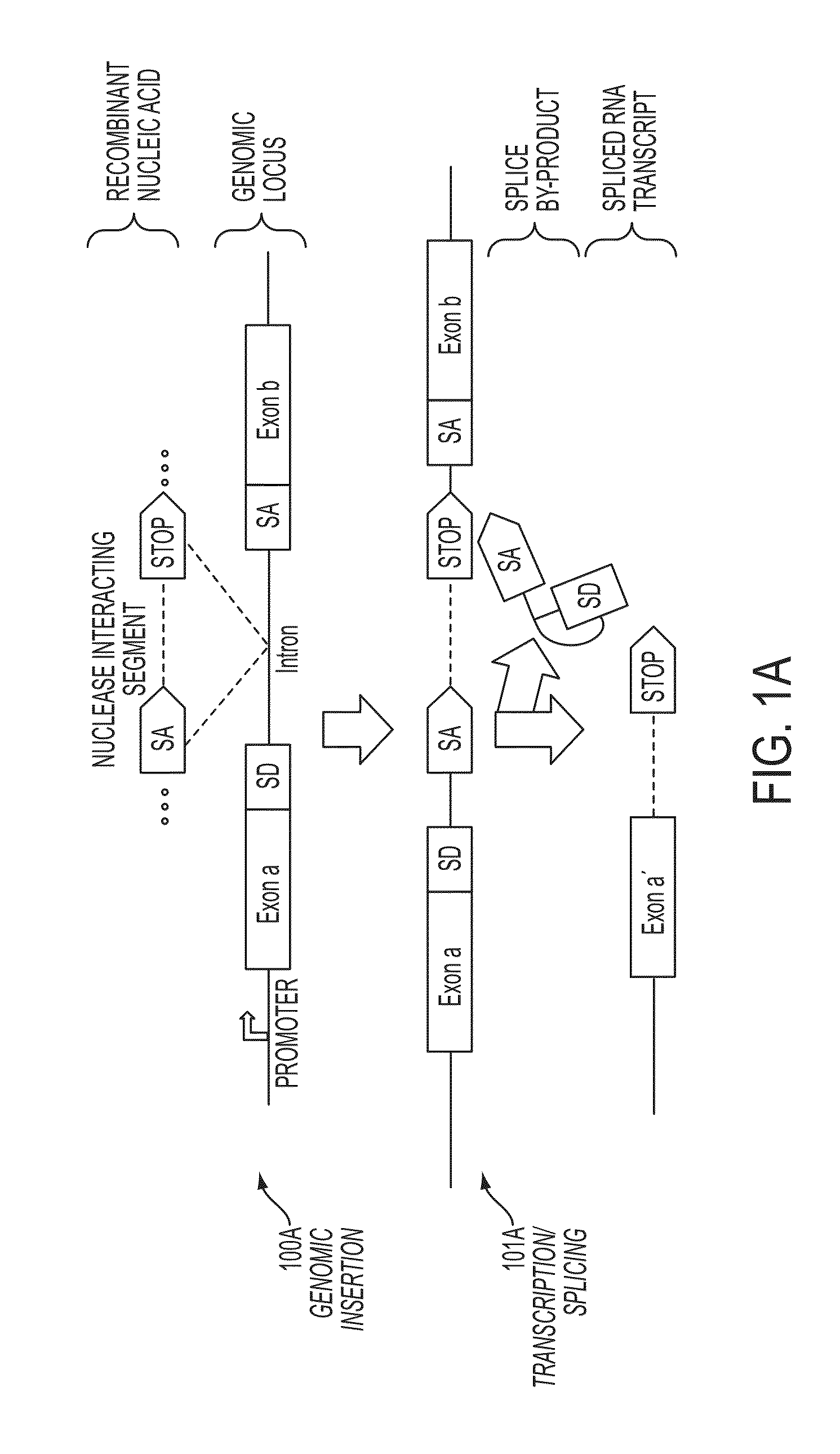Mutagenesis methods
a technology of rna-guided nucleases and methods, applied in hydrolases, biochemistry apparatus and processes, activity regulation, etc., can solve the problem of limited system that uses rna-guided nucleases to produce genomic mutations
- Summary
- Abstract
- Description
- Claims
- Application Information
AI Technical Summary
Benefits of technology
Problems solved by technology
Method used
Image
Examples
example 1
[0101]FIG. 6 illustrates a non-limiting embodiment of an experimental system for generating a chimeric spliced RNA that includes i) an RNA targeting segment corresponding to an exon spliced to ii) a nuclease interacting segment. The nucleic acid construct illustrated in FIG. 6A includes a promoter (CMV promoter) that can drive transcription of an RNA molecule containing i) an experimental target segment (Exon) immediately upstream of ii) a splice donor site (SD) followed by iii) an intervening segment (containing a transposon repeat—PBR) upstream of iv) a splice acceptor site (SA) that is upstream of v) a nuclease interacting segment followed by vi) a polyadenylation site (SV40 pA). In some embodiments, the nucleic acid construct may contain one or more additional elements, including, without limitation, sequences encoding tags (e.g., a MYC epitope) or labels, sequences encoding proteins, (e.g., fluorescent proteins), sequences encoding an internal ribosomal entry site (IRES) that i...
example 2
[0104]In some embodiments, the construct illustrated in FIG. 6A can be used to integrate the segment that is between the transposon ends (PBR and PBL) into a genomic locus (e.g., into an intron) in order to evaluate the ability of the nuclease interacting segment to be spliced to the 3′ end of a natural exon transcribed from a genomic locus. The genomic integration of the segment between the transposon ends can be promoted by a transposase (e.g., PBase). It should be appreciated that this results in a different use of the construct of FIG. 6A than described in Example 1. In Example 1, the splicing occurs with the experimental exon (Exon) that is transcribed from the CMV promoter on the construct. In contrast, after integration into a genomic intron, the splicing occurs with a natural exon that is transcribed from a genomic locus. Accordingly, it should be appreciated that the CMB Exon-SD portion is not required for integration.
[0105]FIG. 7 illustrates a non-limiting embodiment of an...
example 3
[0107]FIG. 9 provides a non-limiting example of a sequence of an insertional recombinant nucleic acid. The recombinant nucleic acid comprises a splice acceptor site upstream of a nucleic acid region that encodes an RNA segment capable of interacting with a RNA-guided nuclease.
[0108]FIG. 10 provides a non-limiting example of a sequence of a nucleic acid engineered to express a Cas9 nuclease.
[0109]While several embodiments of the present invention have been described and illustrated herein, those of ordinary skill in the art will readily envision a variety of other means and / or structures for performing the functions and / or obtaining the results and / or one or more of the advantages described herein, and each of such variations and / or modifications is deemed to be within the scope of the present invention. More generally, those skilled in the art will readily appreciate that all parameters, dimensions, materials, and configurations described herein are meant to be exemplary and that th...
PUM
| Property | Measurement | Unit |
|---|---|---|
| Structure | aaaaa | aaaaa |
| Electrical resistance | aaaaa | aaaaa |
| Fluorescence | aaaaa | aaaaa |
Abstract
Description
Claims
Application Information
 Login to View More
Login to View More - R&D
- Intellectual Property
- Life Sciences
- Materials
- Tech Scout
- Unparalleled Data Quality
- Higher Quality Content
- 60% Fewer Hallucinations
Browse by: Latest US Patents, China's latest patents, Technical Efficacy Thesaurus, Application Domain, Technology Topic, Popular Technical Reports.
© 2025 PatSnap. All rights reserved.Legal|Privacy policy|Modern Slavery Act Transparency Statement|Sitemap|About US| Contact US: help@patsnap.com



